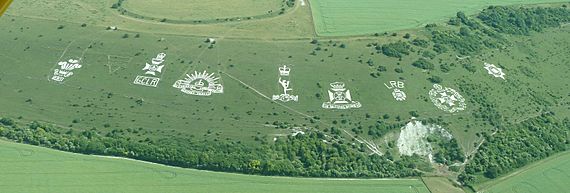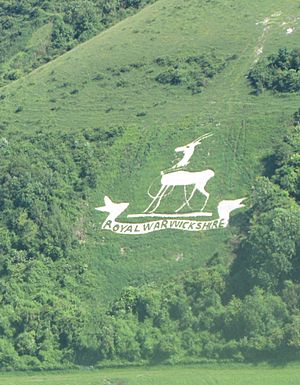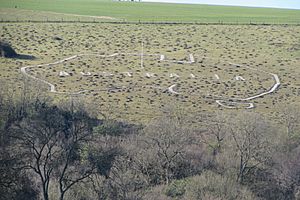Fovant Badges facts for kids
The Fovant Badges are giant pictures of army symbols carved into a chalk hill called Fovant Down. This hill is near the village of Fovant in southwest England. You can see them clearly from the A30 road that goes through the village.
These amazing symbols were made by soldiers during World War I, starting in 1916. The soldiers were waiting to go to France to fight. They carved these badges to represent their army groups. Nine of the original twenty badges are still there today. They are protected as important historical sites and are recognized as war memorials, helping us remember the soldiers. More badges have been added in recent years.
A group called the Fovant Badge Society holds a special service each year. Important people like the Australian High Commissioner attend. These events help raise money to keep the badges looking good.
Contents
How the Badges Were Made
To create the badges, soldiers first cut the outlines into the grassy hillside. Then, they filled these outlines with white chalk dug from a nearby slope. Each badge needed a lot of chalk, sometimes up to 50 tons! On average, it took about fifty men six months to finish one badge. It was a huge effort!
The Badges You Can See Today
If you look at the hill from left to right, here are the badges you can see:
- Royal Wiltshire Yeomanry (only the middle part is left)
- YMCA (this one was fixed up in 2018)
- 6th (City of London) Battalion, London Regiment (City of London Rifles) (people say this was the very first badge made here)
- Australian Commonwealth Military Forces (this is the biggest one, about 51 meters long and 32 meters wide)
- Royal Corps of Signals (made in 1970 to celebrate their 50th birthday)
- Wiltshire Regiment (added in 1950)
- 5th (City of London) Battalion, London Regiment (London Rifle Brigade)
- 8th (City of London) Battalion, London Regiment (Post Office Rifles)
- Devonshire Regiment
The Centenary Poppy Badge
In 2016, a new badge was created to mark 100 years since the first one was made. This badge is shaped like a poppy. Poppies are a symbol of remembrance because they grew on the battlefields of World War I, like "Flanders Fields".
Badges That Are Gone
Many other badges were created on the hills around Fovant during the war, but they didn't last. Some were small or made quickly. Over time, the grass grew back over them, and they disappeared. Some of these included badges for the Royal Army Service Corps, Machine Gun Corps, and the Voluntary Aid Detachment.
Other Nearby Hill Figures
The Fovant Badges aren't the only hill figures in the area!
- On Sutton Down, there's a badge for the Royal Warwickshire Regiment. Volunteers worked to restore it in 2017 and 2018.
- An outline map of Australia was carved on Compton Down by Australian troops. They were training nearby before going to war. This map is also a protected historical site. It was restored by a local group in 2018-2019. A special service was held there on ANZAC Day 2019 to honor the Australian soldiers.
- On Lamb Down, you can find another badge of the Australian Commonwealth Military Force, made in 1916–1917.
- About 20 miles from Fovant, at Bulford Camp, there's a large hill figure of a kiwi bird. This was made by New Zealand soldiers.





